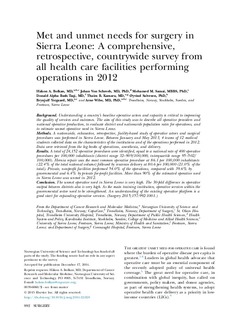| dc.contributor.author | Bolkan, Håkon Angell | |
| dc.contributor.author | Schreeb, Johan | |
| dc.contributor.author | Samai, Mohamed | |
| dc.contributor.author | Bash-Taqi, Donald Alpha | |
| dc.contributor.author | Kamara, T. B. | |
| dc.contributor.author | Salvesen, Øyvind | |
| dc.contributor.author | Ystgaard, Brynjulf | |
| dc.contributor.author | Wibe, Arne | |
| dc.date.accessioned | 2017-10-09T08:02:28Z | |
| dc.date.available | 2017-10-09T08:02:28Z | |
| dc.date.created | 2017-10-06T17:31:37Z | |
| dc.date.issued | 2015 | |
| dc.identifier.citation | Surgery. 2015, 157 (6), 992-1001. | nb_NO |
| dc.identifier.issn | 0039-6060 | |
| dc.identifier.uri | http://hdl.handle.net/11250/2459091 | |
| dc.description.abstract | Background. Understanding a country’s baseline operative actors and capacity is critical to improving the quality of services and outcomes. The aim of this study was to describe all operative providers and national operative production, to evaluate district and nationwide population rates for operations, and to estimate unmet operative need in Sierra Leone.
Methods. A nationwide, exhaustive, retrospective, facility-based study of operative actors and surgical procedures was performed in Sierra Leone. Between January and May 2013, 4 teams of 12 medical students collected data on the characteristics of the institutions and of the operations performed in 2012. Data were retrieved from the log books of operations, anesthesia, and delivery.
Results. A total of 24,152 operative procedures were identified, equal to a national rate of 400 operative procedures per 100,000 inhabitants (district range 32–909/100,000, interquartile range 95–502/ 100,000). Hernia repair was the most common operative procedure at 86.1 per 100,000 inhabitants (22.4% of the total national volume) followed by cesarean delivery at 80.6 per 100,000 (21.0% of the total). Private, nonprofit facilities performed 54.0% of the operations, compared with 39.6% by governmental and 6.4% by private for-profit facilities. More than 90% of the estimated operative need in Sierra Leone was unmet in 2012.
Conclusion. The unmet operative need in Sierra Leone is very high. The 30-fold difference in operative output between districts also is very high. As the main training institution, operative services within the governmental sector need to be strengthened. An understanding of the existing operative platform is a good start for expanding operative services. (Surgery 2015;157:992-1001.) | nb_NO |
| dc.language.iso | eng | nb_NO |
| dc.publisher | Elsevier | nb_NO |
| dc.rights | Attribution-NonCommercial-NoDerivatives 4.0 Internasjonal | * |
| dc.rights.uri | http://creativecommons.org/licenses/by-nc-nd/4.0/deed.no | * |
| dc.title | Met and unmet need for surgery in Sierra Leone: a comprehensive retrospective countrywide survey from all healthcare facilities performing surgery in 2012 | nb_NO |
| dc.type | Journal article | nb_NO |
| dc.type | Peer reviewed | nb_NO |
| dc.description.version | publishedVersion | nb_NO |
| dc.source.pagenumber | 992-1001 | nb_NO |
| dc.source.volume | 157 | nb_NO |
| dc.source.journal | Surgery | nb_NO |
| dc.source.issue | 6 | nb_NO |
| dc.identifier.doi | 10.1016/j.surg.2014.12.028 | |
| dc.identifier.cristin | 1502940 | |
| dc.description.localcode | © 2015 The Authors. Published by Elsevier Ltd. This is an open access article under the CC-BY-NC-ND 4.0 license (http://creativecommons.org/licenses/by-nc-nd/4.0/) | nb_NO |
| cristin.unitcode | 194,65,15,0 | |
| cristin.unitcode | 194,65,1,0 | |
| cristin.unitname | Institutt for klinisk og molekylær medisin | |
| cristin.unitname | MH fakultetsadministrasjon | |
| cristin.ispublished | true | |
| cristin.fulltext | original | |
| cristin.qualitycode | 2 | |

